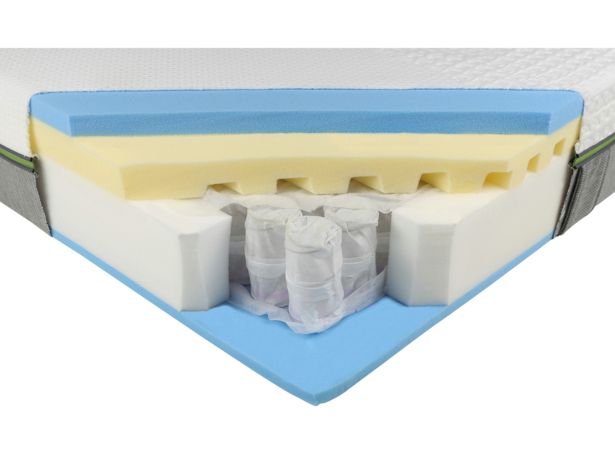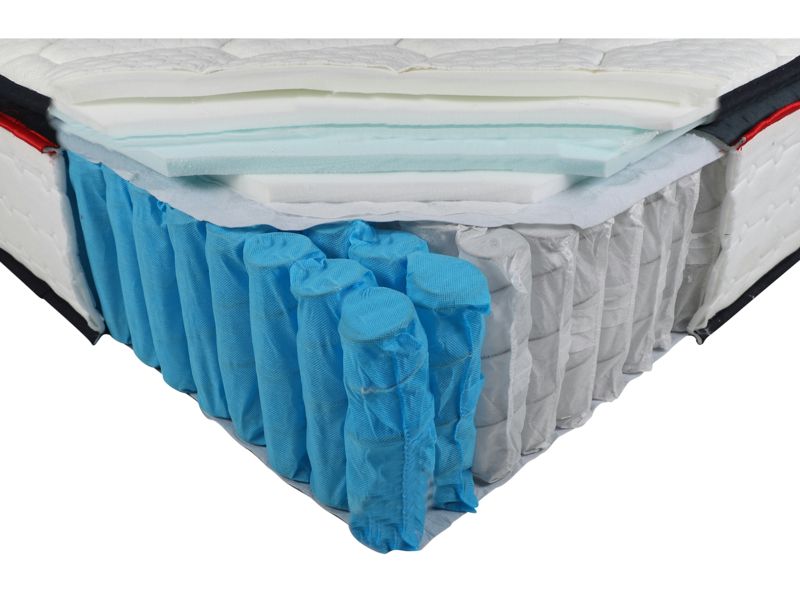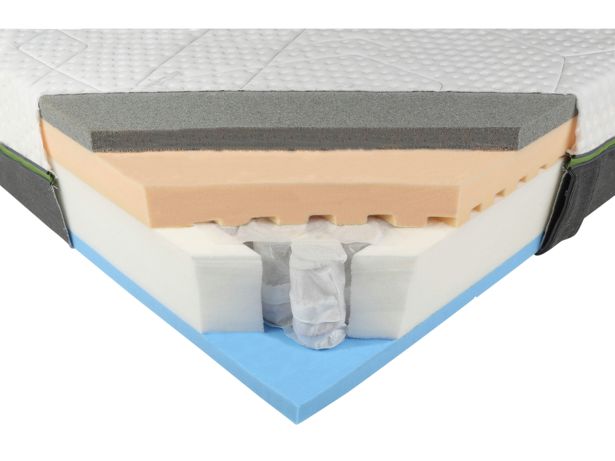By clicking a retailer link you consent to third-party cookies that track your onward journey. If you make a purchase, Which? will receive an affiliate commission, which supports our mission to be the UK's consumer champion.
How we test mattresses

We test dozens of mattresses in our specialist test lab every year, but what do we actually do to them, and why are our tests the most rigorous around?
Almost all free-to-access websites review mattresses using an individual tester and generate scores based on that individual’s preferences. Free sites also typically get mattresses free of charge directly from manufacturers or their PR representatives.
Which? buys every mattress we test, and we do not accept free samples for any of our full lab tests, so you can have complete confidence in our recommendations. The Which? overall test score is calculated purely on the measurements and ratings supplied by our independent testing at our specialist labs, meaning there is no room for unconscious bias when compiling the overall ratings.
See the best mattresses from our tests.
What are Which? Best Buy, Great Value, Eco Buy and Don’t Buy mattresses?

A quick guide to the recommendations you'll see on our mattress reviews.
Best Buy mattresses
The mattresses that impress the most in our lab tests become Best Buys. Any mattress that scores 74% or above is a Best Buy and comes with our solid overall recommendation, although you should still read our reviews to check for any factors that might impact your buying decision.
Best Buy mattresses typically tick the most important boxes. They provide long-lasting support for your spine in most, if not all, sleeping positions and are also likely to be breathable and good at preventing the transfer of movement from one side of the bed to the other.
Great Value mattresses
If you’re in desperate need of a new mattress, but you don’t have spare cash or a massive budget, our Great Value mattresses are the ideal choice.
Great Value mattresses are at least 20% cheaper than the average price of the mattresses we’ve tested, per type (pocket sprung, hybrid and memory foam/foam) and, most importantly, they all do pretty well in our tests – scoring 65% or more.
A Great Value mattress must also score three stars or better for durability, and three stars or better in all our key body-support tests.
Some Great Value mattresses also score high enough to be a Best Buy.
Eco Buy mattresses
Do you want help to make a more sustainable choice when it comes to buying your next mattress? Then a Which? Eco Buy mattress is for you.
Our Which? Eco Buy recommendations highlight the products constructed using materials with the smallest environmental impact (Co2 equivalent) based on life cycle analysis data available to us, compared to all the models we’ve tested in their category, but Eco Buys have to be more than just 'green'.
They also have to have scored well in our standard tests, so you can be sure they'll also be great at their job.
Receiving an Eco Buy accolade is no mean feat. A mattress will need to perform well and tick a lot of boxes, as we’re quite tough on what a mattress needs to be eligible.
To become an Eco Buy, a mattress must:
- Be a double mattress tested to our latest test programme
- Earn a total test score of 68% or more
- Achieve good results in our body support tests in each sleeping position
- Not sag, soften or show signs of damage following our tough durability tests
- Have excellent build quality
- Achieve at least a ‘good’ rating for sustainability which includes the carbon footprint of the mattress and whether the layers can be separated for recycling. If it has a washable cover, it must be removable and wash without shrinking
We also check that each brand achieves a good comfort rating in our annual survey of mattress brands. However, as comfort is subjective, this doesn’t affect the overall score.
For the moment, our mattress sustainability star ratings will not affect the overall score of each mattress but we hope to make this happen next year when we’ll have tested more mattresses and have more data available to us.
Fewer than 5% of mattresses currently are Eco Buys.
For the moment, our mattress sustainability star ratings will not affect the overall score of each mattress, but we hope to make this happen in the future when we’ll have tested more mattresses and have more LCA data available to us.
Don't Buy mattresses
Any mattresses that score 45% or less become Don't Buys and are poor in multiple areas so we recommend you avoid them.
Don't Buy mattresses fall down in important areas – usually they're either unsupportive or struggle to stand the test of time, if not both.
Go to our mattress reviews to see all our Best Buy, Great Value and Don’t Buy mattresses.
How is the Which? score calculated?

The Which? overall score is a percentage. This score only takes into account the results of our tests and ignores price completely.
This means that all mattresses are tested on exactly the same scale, so you can compare any model at any price and know how it measures up against its rivals in key areas. All mattresses are tested in the same way, regardless of the manufacturers’ claims or prices.
Weightings and star ratings
A Which? test score is made up of dozens of individual tests and checks, from key factors such as body support and durability to breathability and stability.
To keep things simple, the most important scores are shown as star ratings out of five on the 'test results' page of each mattress review, so you can quickly work out whether a model is right for you.
The most important test results have a greater impact on a mattress’s overall score.
- Performance (including how well it supports your body, pressure distribution, breathability and stability) (55%)
- Durability (40%)
- Ease of use (5%).
Our key testing criteria

Below are the key testing categories and how we evaluate each one.
We use double mattresses in our tests.
Performance
Our performance measure includes our test results for body support, stability, turning on the mattress and breathability.
Key question: how well will the mattress support my back in the position I usually sleep in?
A good mattress keeps your spine in the same shape as when you’re standing up. To assess each mattress for back support, we measure 36 different points along a body when standing, and then when lying down on the mattresses.
We measure the spine's position when lying on the side, to check that no parts sink too far into the mattress. A good mattress keeps your spine in line and parallel to the mattress.
We also measure a third time to assess how supportive each mattress if for people lying on their front.
For all support tests, we use different body types to check how suitable each mattress is for a wide range of buyers.
Our body-support tests account for the largest proportion of our wider performance tests, which in turn account for 55% of a mattress's total test score.Key question: is pressure distributed evenly across the mattress?
If your hips, shoulders or another part of your body sinks into one section of a mattress too much, it could cause pressure in this area and may lead to discomfort. This could also aggrevate any back or hip pain you already experience.
As of November 2022, to see which mattresses evenly distribute pressure across a mattress surface, we use specially designed equipment – a pressure sensor mat equipped with more than 10,000 sensors, linked up to computers to reveal which areas you may sink into. The best mattresses avoid these pressure spots and keep you well supported all over.
Key question: does the mattress move a lot when my partner turns on it?
A mattress that jiggles and bounces each time your partner moves in the night can disturb your sleep, so we measure whether you'll feel the mattress moving when a sleeping partner turns on it. We call this 'mattress stability': a poor mattress will be super bouncy and get a one-star rating, however if you sleep alone this may not be an issue, so read our full reviews to find out.
A good mattress will be stable enough to prevent movement from transferring from one side of the bed to the other. You'll be able to find these by looking at mattresses rated four or five stars. Three-star mattresses are those that do an acceptable job, but may be a little bouncy.
Key question: is the mattress easy to roll over on or does it restrict my movement?
We assess how easy it is to roll over on the mattress for when you want to switch sleeping positions during the night. Some mattresses restrict your movement or, even worse, dip in the middle, meaning it requires a lot more effort to roll over.
Key question: will the surface of the mattress become damp with sweat on a muggy night?
We use specially designed humidity chambers to measure how much moisture can pass through the layers of each mattress we test. Highly breathable mattresses allow lots of moisture to pass through, so even on very humid summer nights, or if you suffer with hot flushes or night sweats, the surface of the mattress is unlikely to become damp with sweat as the moisture passes through the mattress layers.
Breathability is different to how warm a mattress feels to lie on. We also test mattress insulation, but we don't factor this into a mattress' test score because some people prefer warmer mattresses, while others prefer cooler ones.
Durability
Key question: will the mattress stand the test of time?
In our tests, heavy barrels are run back and forth across each mattress thousands of times, to simulate approximately 10 years of use.
We then examine whether the mattress becomes harder or softer over time, and whether the mattress starts to sag, becomes less supportive or is damaged in any other way.
A good mattresses will stay in a similar condition to when you first bought it, even after heavy use.
Ease of use
Key question: is the mattress easy to flip or rotate?
Pretty much every mattress either needs to be flipped from time to time or regularly rotated from head to toe to keep it in good condition.
But when the average weight for the double mattresses we’ve tested is over 32kg and the heaviest we've tested weighs over 68kg, this is no mean feat.
We find that many mattresses don't come with any handles or adequate grips to make moving them easier. So, as part of our mattress tests, we assess how easy each mattress is to manoeuvre.
Why isn’t mattress firmness or softness included in the test score?
Mattress softness is subjective and down to many factors, including your own personal preference, the state of your current mattress and what type you buy new. That’s why it’s not something we can factor into our final mattress scores.
We do however, use a specially designed machine to objectively measure mattress firmness so we can include a rating in our reviews. It’s based on the mattress standard, and we use a scale of one (firmest) to 10 (softest). We test each mattress in exactly the same way, so they are comparable.
Changes to our mattress testing

We constantly improve our mattress tests to ensure only the very best ones become Best Buys. This means that newer mattresses have been tested and rated in a slightly different way to older models, but you can still use the overall test scores to compare one mattress with another.
Best Buy score
From time to time we change the minimum score a mattress requires to become a Best Buy, so that only the very best mattresses on the market achieve this endorsement. In June 2024, we raised the minimum Best Buy score from 73% to 74%.
Pressure distribution test
In November 2022, we added a pressure distribution assessment to our mattress testing, to check mattresses are equally supportive all over. The pressure distribution star rating won’t feature in the specs of the mattresses we tested before then.
Front sleeping test
In November 2019 we added a front-sleeping position to our body support tests. While many mattresses tested at this time have now been discontinued, or we’ve retested newer versions. The front-position star rating won’t feature in the test results of mattresses tested before then
See all our mattress reviews.



